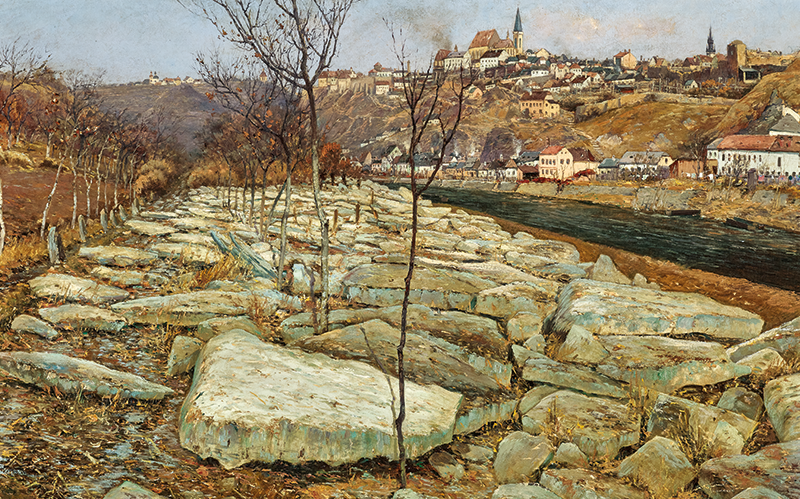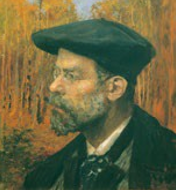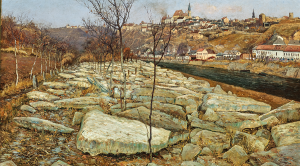
When There Were Still Ice Floes in Winter
Ice Floes on the Banks of the Thaya, one of Theodor von Hörmann’s major works, is up for sale in April. The “reality fanatic”, who overcame realism in his search for authenticity and is considered a pioneer of Austrian Modernism, depicts the magnificent natural spectacle with a painterly sophistication full of contradictions.
March 1891. The winter had been cold, chilling-cold even, and the picturesque, sometimes wild River Thaya, which playfully marks the border between Lower Austria and Moravia (today the Czech Republic) with its striking meandering, had been covered by a layer of ice almost a metre thick. But now, at long last, the spring had arrived, and the longed-for warmth was returning. It must have sounded eerie to the residents of the small town of Znojmo when the ice broke in a million places with a loud crash – a crunching and roaring when the elements fight each other in a relentless battle. There they lay, those huge floes of ice, waiting to melt or to be put to a different use. (In the time before refrigerators, ice was used in cellars and caves to cool all kinds of foodstuff.)
In March 1891, many residents of Znojmo were probably amazed to see the tall, stately man with thick black hair and the inevitable pipe in his mouth, who spent days painting on the banks of the then still untamed Thaya. Early in the morning, stoically defying the cold, he would place his wooden board on the easel to capture, with a keen eye, this strange scene of ice and cold earth, of winter and spring.

Theodor von Hörmann had arrived in Znojmo a year earlier, taking up quarters at the Gasthof “Fasching” on the bank of the River Thaya with his wife Laura. The one time officer who had taught at St Pölten had come a long way. He taught himself to paint and spent extremely fruitful and inspiring years in Paris where he was introduced to the pictorial freedom and diversity of the impressionistic portrayal of nature. After his return, he unexpectedly went to Znojmo, probably looking for peace and nature, some sort of a small Barbizon within easy reach of the metropolis of Vienna. This decision proved less-than-ideal for his career, but was good for his art, because in those four years – the last of his short life as an artist – he created major works not only in terms of his œuvre, but also of Austrian painting, then on the threshold of modernity and the Secession, which he masterminded and initiated.
An undisputed masterpiece, Ice Floes is perhaps one of the last main works to be offered on the market. Painted on canvas, it is of considerable size, 70 cm by 100 cm and is the final version of a series of three ice floe pictures. Hörmann used very specific details to challenge the obviousness of motifs and the indifference of seeing. In terms of composition, this is reflected in a sophisticated combination of emphasized diagonals – such as the course of the riverside path here – and a dramatically raised horizon line: the illusion of space in the old tradition of a central perspective collides with horizontal image layers stacked on top of each other in an irritating flat pictorial arrangement. And while the path, dramatically leading into the distance, provides a sense of depth and breadth, the consistent sharpness of the portrayal makes the houses and churches in the background appear surprisingly close. Dynamic contradictions, combined with harmonious integration, can also be seen in the painterly execution: the meticulous, almost naive rendering of the houses and churches of the picturesque hilltop town of Znojmo is counteracted by a “chaos” of brushstrokes, sometimes opaque, then again capturing the magnificent natural spectacle of the ice floes in fine, gesturally applied lines. And it would not be Hörmann if the subject was not rendered with the attractive playfulness which challenges perception: thin, fragile-looking birch trunks stand amidst mighty ice floes, the epitome of the force of nature. The floes seem tamed in their wild chaos, pulled out of the water by people, while the young trees reach upwards in a strictly linear arrangement, playful and victorious, heralding a new year.

AUCTION
19th Century Paintings, 25 April 2024, 18:00
Palais Dorotheum, Dorotheergasse 17, 1010 Wien
19c.paintings@dorotheum.at
Tel. +43-1-515 60-355, 765, 501













